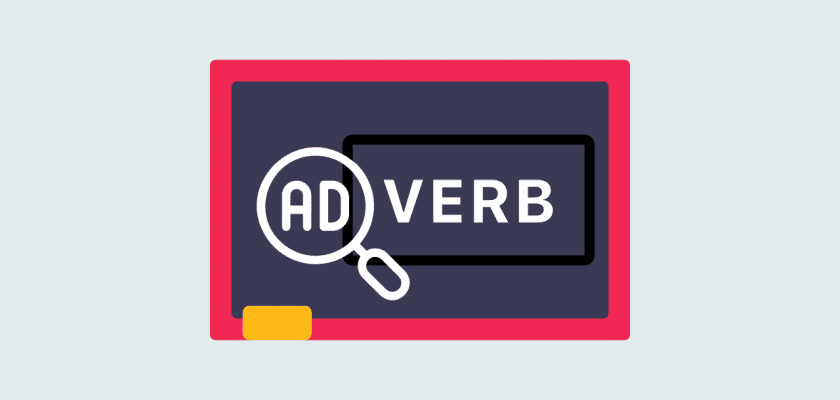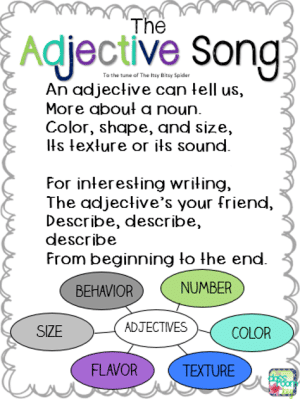Adverbs are words that modify. They answer the tacit questions of:
- When?
- Where?
- How?
- How much?
- How long?
- How often?
Adverbs can often be recognized by the suffix -ly, although this isn’t the case 100% of the time. Not all words ending in -ly are adverbs, and not all adverbs end in -ly. But this is the case frequently enough that recognizing -ly ending words can be a good starting point for young students.
Table of Contents
- Elements of a Good Adverb Anchor Chart
- Adverb Anchor Chart Resources from Teach Simple
- Adverb Scrabble
- Adverb Anchor Chart Examples from Teachers
- Free Resources
Elements of a Good Adverb Anchor Chart
Adverbs are not necessarily as complicated as other parts of the sentence that include many different rules and types. Simply conveying the definition of adverbs is most likely what you’ll need to accomplish with an adverbs anchor chart. So make sure that yours first displays a clear title. It can be as simple as “Adverbs,” or it can be more creative like you’ll see below with “Ava Adverb.”
Often, an anchor chart benefits from having a definition of the subject in question. You’ll find anchor charts detailed below that have wonderfully pithy definitions, or even no definition at all, leaving students to infer based on the examples given.
This leads us to perhaps the most important element of a good adverb anchor chart: examples of adverbs. And many anchor charts separate examples by the question they answer. That’s a smart way to help students remember what those questions are.
Have a look through the following resources and examples to source an adverb anchor chart for your own classroom, or to draw inspiration for creating your own.
Adverb Anchor Chart Resources from Teach Simple
Circle Adverbs Worksheet
Have Fun Teaching
While not an anchor chart itself, this worksheet provides good practice for identifying adjectives from other parts of the sentence. A bank of 27 words are listed. Students can circle which words are adverbs. At the bottom of the worksheet, a few blank lines are given for students to choose two adverbs from the list and write a sentence for each.
Adverb Scrabble
Have Fun Teaching
Also not directly an anchor chart, but this is a really fun and creative way to practice and deepen students’ understanding of adverbs. This worksheet features a Scrabble board with only the word “adverb” running down the middle. Students must come up with as many adverbs as they can to fill the rest of the board. This would make a fun activity to do together with the class and then display on the wall afterward.
Adverb Anchor Chart Examples from Teachers
Adverbs Describe Verbs
Marcy | Saddle Up For 2nd Grade
It isn’t always the case that adverbs describe verbs, but this is a great place to start if you’re a teacher of younger students like Marcy from Saddle Up For 2nd Grade. This simple anchor chart is titled “Adverbs.” Underneath that, it gives a short and sweet definition: “describes verbs.” Three categories to describe verbs are delineated below, with a column each for “how,” “when,” and “where.” A good amount of examples are listed in each column, with the suffix -ly underlined for the examples given in the “how” category. Students can easily observe from the underlining that the -ly additions occur only in the “how” category, but that not all “how” adverbs end in -ly.
When? Where? How? How Often?
The Teacher Next Door
Another really simple anchor chart, this one additionally includes the common adverb category of “how often.” With no definition for adverbs given, students can infer the meaning of adverbs from the four rows of categories and the examples given. This anchor chart makes great use of color, color coding each category of information on the page to convey meaning quickly.
Ava Adverb
Erica Davis
This anchor chart is pretty simple as far as content. It gives a basic definition of adverbs and then lists a few examples. But this one is fun because it features a character, Ava Adverb. And there are many examples out there of anchor charts that show the same idea with other A names, as well. You could get creative with your own A-name character. Have your students brainstorm names they like and vote on a winner to be featured on your adverb anchor chart.
Suffix -ly Anchor Chart
Smitten with First
The suffix -ly doesn’t always mean an adverb, but frequently it does. This anchor chart is a creative way of demonstrating that for students as the display itself is a big cutout of the lowercase letters “ly.” Inside the letters are a bunch of examples of words that end in “ly.” In the middle of it all, the chart explains that -ly is a suffix and that we use it at the end of words. At the very bottom, we see that -ly adverbs mean “like” or “manner of.”
Sticky Note Anchor Chart
Smitten with First
This anchor chart also comes courtesy of Smitten with First. What’s great about it is the examples are done in sticky notes. So not only can students participate by brainstorming adverbs to use on the chart or by placing the correct sticky note to the correct categories of “how,” “when,” and “where,” but this chart can be reused over and over again.
Free Resources
The Adverb Song
The Classroom Key
Music is linked to memory. A study from Harvard found that listening to and performing music boosts memory, among many other benefits. Not only does music help us access memories, but it helps us lay down new ones. So it makes a lot of sense to teach any topic using music. Plus, it’s just more fun for both you and your students. These lyrics for “The Adverb Song” can be sung to the tune of “The Itsy Bitsy Spider.” Visit the link and you’ll find a printable PDF to hang in your own classroom.
In-Depth Adverb Anchor Chart
Upper Elementary Snapshots
Of the anchor charts on this list, this final example goes the most in-depth about adverbs. First, we see a brief definition: adverbs modify. Arrows point to three types of words that adverbs modify, including verbs, adjectives, and other adverbs. Under the verbs column, we see separate boxes further categorizing adverbs that modify verbs into “where?” “when?” “in what way?” and “to what extent?” Under “adjectives” and “other adverbs,” we also see the categories “to what extent?” Each box includes one example sentence using an appropriate adverb. In addition to these boxes, the anchor chart advises that words ending in -ly aren’t always adverbs and lists a few examples of verbs, adjectives, and nouns that also end in -ly. If you scroll below that on Deb Hanson’s blog post, you’ll see she offers a blank printable version of the anchor chart you can complete with your own students.
Adverbs are an important part of sentence structure, so your students should know them and love them! You can help kids get the hang of things easier with a handy adverb anchor chart on display in your classroom or even in their folders for quick reference.




